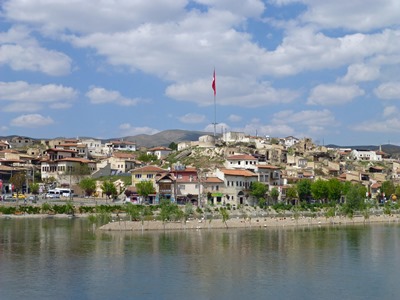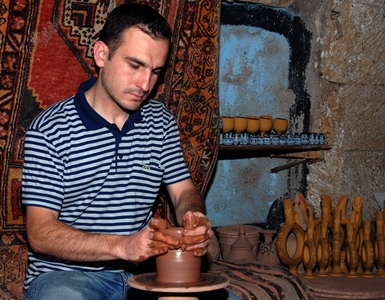Avanos Town - Town of pottery & craftsmanship
 Avanos, which was known in the Hittite period as Zu-Winasa, or Nenassa, was called Venessa in the Greek and Roman period and Vanote in the Byzantine according to some historians. The name Avanos is believed to derive from Evranos Bey, a Seljuk military commander. In his ‘Geographika’, written between 58 BC. and 25 AD., the Roman historian Strabo explains that in the political and religious sense Venessa was the third most important city of the Cappadocian Kingdom after Mazaca (modern Kayseri) and Tyana or Eusebia (modern Kemerhisar). Avanos, which was known in the Hittite period as Zu-Winasa, or Nenassa, was called Venessa in the Greek and Roman period and Vanote in the Byzantine according to some historians. The name Avanos is believed to derive from Evranos Bey, a Seljuk military commander. In his ‘Geographika’, written between 58 BC. and 25 AD., the Roman historian Strabo explains that in the political and religious sense Venessa was the third most important city of the Cappadocian Kingdom after Mazaca (modern Kayseri) and Tyana or Eusebia (modern Kemerhisar).
Avanos and its environs, like the entire Cappadocia region, escaped Roman oppression and acquired importance with the habitation of the early Christians here, becoming one of the principal centres of settlement in the region. The city’s architecture also attests to this in structures such as Yamanlı Church, one of the oldest in Cappadocia, the Sarihan Caravanserai, built by the Seljuks in the 13th century of the local yellow volcanic stone, the Alaaddin Mosque, a Seljuk monument that has been open for worship for centuries, and the Mansion of Doctor Hacı Nuri Bey, one of the oldest surviving Avanos houses.
Set on the banks of the Kizilirmak, the Red River, about 8 km (5 miles) from Goreme, Avanos has a lively centre with all the usual amenities including a modern, tourist-oriented hamam (Turkish bath). A large travelling market visits Avanos on Fridays.
Starting just outside the shopping centre the old village of Avanos winds up the hills leading away from the town and is a beautiful maze of old stone houses, some restored, some converted and some sadly abandoned to their fate. In some of the abandoned houses the features of traditional Ottoman architecture can be recognised along with ancient decorations, motifs and murals.
Throughout history, humanity has always been resourceful. They took the features and benefits of the landscape and used it to their advantage, whether it was building castles on hills for an optimum view of their approaching enemy or building settlements and villages near a source of water.
Kizilirmak (the Red River) is also the longest river in Turkey and it does not only separate the town from other parts of Cappadocia, but also gives the supplies the clay for pottery. It is by this river that the red pottery clay is found from which, Avanos derives its main livelihood and its foremost claim to fame.
 When you pass the mansion, which dates to the early 1900- s and enter the centre of Avanos, the pottery workshops begin to appear. Known by the locals as «ishlik» or «chanakhane», these workshops are striving to keep the pottery tradition alive today. Avanos is now the sole centre of pottery-making in all Cappadocia. Although it is not known exactly when pottery-making began here, according to some sources it dates back as far as the Hittites. Pottery-making in Anatolia began in the Neolithic, sometime in the 8th millennium BC at Catalhoyuk. The Assyrians who came from Mesopotamia in the 3rd millennium BC taught the art to the Hittites. What is known is that the first examples of pottery were shaped by the wrapping-rolling method and baked over an open fire. When the potter’s wheel was invented in the 3rd millennium B.C. pots were shaped on it and the first primitive kilns also came into use. Although data are scarce due to the lack of comprehensive excavations, we do know that pottery belonging to the Chalcolithic culture has been found in the townships of Hacıbektas and Gelveri (Guzelyurt) and that pottery was still being made at Gelveri at the beginning of the 20th century. The Aksaray Pottery unique to Avanos is also known to have been produced in the style of the Gelveri masters. When you pass the mansion, which dates to the early 1900- s and enter the centre of Avanos, the pottery workshops begin to appear. Known by the locals as «ishlik» or «chanakhane», these workshops are striving to keep the pottery tradition alive today. Avanos is now the sole centre of pottery-making in all Cappadocia. Although it is not known exactly when pottery-making began here, according to some sources it dates back as far as the Hittites. Pottery-making in Anatolia began in the Neolithic, sometime in the 8th millennium BC at Catalhoyuk. The Assyrians who came from Mesopotamia in the 3rd millennium BC taught the art to the Hittites. What is known is that the first examples of pottery were shaped by the wrapping-rolling method and baked over an open fire. When the potter’s wheel was invented in the 3rd millennium B.C. pots were shaped on it and the first primitive kilns also came into use. Although data are scarce due to the lack of comprehensive excavations, we do know that pottery belonging to the Chalcolithic culture has been found in the townships of Hacıbektas and Gelveri (Guzelyurt) and that pottery was still being made at Gelveri at the beginning of the 20th century. The Aksaray Pottery unique to Avanos is also known to have been produced in the style of the Gelveri masters.
REGIONS AND SITES OF CAPPADOCIA
♦ Underground City of Derinkuyu - the largest & deepest excavated subterranean city, which could house up to 20.000 people
♦ Underground City of Kaymakli - the next largest excavated subterranean city, which could house up to 5.000 people
♦ Göreme National Park & Open-air Museum - cave churches with frescoes
♦ Zelve Valley & Open-air Museum - an empty cave town with churches
♦ Paşabağ (Monk Valley) - mushroom-shaped fairy chimneys
♦ Ihlara Valley - the deepest gorge of Anatolia
♦ Devrent Valley (Imagination Valley) - animal-shaped fairy chimneys
♦ Uchisar Castle - A rock-cut castle. You’ll see it driving back and forth
♦ Ortahisar Castle - Troglodyte village with rock-cut castle
♦ Sobessos - The only late-Roman/early-Byzantine settlement found in Cappadocia, mosaic pavements, Roman baths
♦ Avanos Town - Town of pottery & craftsmanship
♦ Hacibektaş Town - Centre of Bektasi sect of Islam
♦ Gülşehir Town - First settlements in Cappadocia
♦ Caravanserais - Inns, «caravan palaces» on camel trains through Asia Minor
|



